Spain and Cuba; A 500-year-old
Affair
By Megan
Lardner
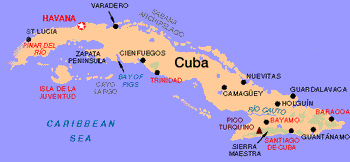 |
|
photo
from Yahoo maps
The
"faithful island." authors visited Pinar del Rio, Varadero,
Trinidad, Havana as well as several other towns and cities to
research their stories.
|
"The old Spanish empire
is no longer capable of dominating the lands of young America."
- José Marti, 1890
Ivan, a Cuban philosophy
student, still remembers the scene vividly: It was January 2001 and
the Spaniards had descended on central Havana, draped in robes like
royalty from the 1500s. In the lead, three men in a horse-drawn carriage
rolled leisurely along the tree-lined Paseo del Prado to the clattering
rhythm of hooves. Behind
them, a troop of Spaniards fanned out along the street, throwing candy
to Cuban children. With the kids in fast pursuit, the entourage glided
past crumbling colonial homes and emerged in front of the Spanish Cultural
Center's newly refurbished seafront mansion. There the crowd thickened
and the candy supply ran low. People began to push and grab excitedly,
trampling some children in the midst of the confusion. One of the costumed
Spaniards was especially rude. When
the gifts ran out, he told the kids to get lost. Meanwhile, Cuban television
crews captured the images.
The Spaniards - modern day
diplomats and executives dressed up as the biblical Wise Men for a traditional
Spanish Epiphany parade - barely made it back to their offices before
the eruption. Local press called the Spaniards "undignified clowns"
and "imported monarchs" whose dangerous show encouraged Cuban
children to fight over material objects. In response to the affront,
Cuban officials held a conference called "Neither Kings, Nor Wise
Men" and Fidel Castro warned: "We don't want to add fuel to
the fire in our relations with Spain, but let no one doubt that any
rudeness, provocation, or insult will receive an appropriate response."
His threat is no joke. The original Epiphany parade was banned 40 years
ago after Castro's revolution reinvented Cuba and emphasized national
pride over historical ties. By resurfacing now, the Spanish-sponsored
religious celebration has sparked resentment. Spain, for its part, pleads
innocence. "Our presence is not some kind of re-colonization of
Cuba," says José María Coso, director of the Spanish
Cultural Center in Havana and the parade organizer. He lifts a Cuban
cigar lovingly to his lips and gently exhales smoke. "We're just
trying to preserve our place here."
If most divorced couples
married for 20 years complain about emotional baggage, imagine the unresolved
issues shared by two countries with a 500-year old relationship. During
many of those years, they fought. Then in 1898 after a long, bloody
war, Spain finally picked up its belongings and sailed home. But it
left behind 50,000 soldiers who changed the face of the island; today
their descendants populate Havana's boardwalk among the silhouetted
fishermen and young couples stealing kisses at sunset. If the Cuban
government has gone through several changes of heart toward Spain since
1898, developments in the past ten years also demonstrate the nations'
enduring connections; how a former colonizer has become a necessary
ally; how in the era of globalization, blood proves thicker than water
and makes for some odd couples. Yet the emotional baggage remains.
| Losing
Cuba was a psychological disaster for Spain, like losing a limb. |
Unlike young love, the two
nations are embroiled in a complicated affair. The Spanish lost the
island a century ago, but are now returning to Cuba as business executives
and benefactors. They began arriving in 1991, when Cuba hit an economic
wall after the fall of the Soviet Union. Spain's socialist government,
led by Felipe Gonzalez, rushed to the rescue with millions of dollars
in aid. Gonzalez also encouraged Spaniards to invest. One of the early
arrivals was Carlos Pereda, who opened Cuba's first tourist hotel in
what used to be the sleepy coastal village of Varadero. The town –
a two-hour ride from Havana along sleek highways – has thrived
on the bitter-sweet fruits of tourism. Today pricey Spanish and international
hotels hug the coastline, shaded by thousands of perfectly cloned palm
trees. From a windowless office just steps away from warm Caribbean
waters, Pereda is working after hours on a steamy Saturday evening.
His telephone rings constantly, and the grandfatherly Spaniard jokes
amiably with the callers. Fluorescent ceiling lights glint off a dozen
wall plaques that mark a decade of success. "It was like night
and day when I came to Cuba," he says in an accent still thick
with the lisping zeta of Spain. "Imagine arriving in a country
where 75 percent of your work force is university educated, and the
other 25 percent is highly educated. Here when it comes time to pitch
in to help with a government project, everyone contributes."
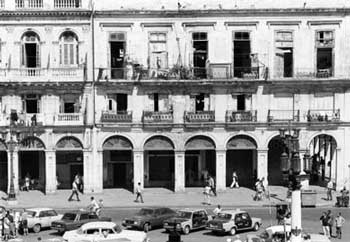 |
|
photo
by Mimi Chakarova.
A view of
Havana.
|
Pereda isn't the only one
impressed by the Cuban work force. The tide of incoming Spanish investors
has flowed so swiftly in recent years that they founded the Association
of Spanish Business Executives in Havana. Its president, Rafael García
Arnal, is a friendly Barcelonan with a taste for Habanos cigars. His
optimism is clear as he runs through the statistics; membership is up,
with some 100 Spaniards representing everything from banks to food services
to hotels; there are nearly 200 Spanish businesses on the island compared
to just 36 in 1994; and Spanish firms make up 25 percent of total foreign
investment and 40 percent of all European Union trade with the island.
"We're not just thinking about the distant future – we're
making money now," García Arnal says, his affable face red
from too much Caribbean sun. Like him, other Spaniards are beginning
to call the lush island home. But the club president still looks forward
to his yearly vacations in Spain. "I go there to refresh myself,"
he jokes, alluding to Cuba's harsh political and economic landscape.
Even with the challenges,
Spaniards are reveling in their new connection with Cuba and it seems
that all they touch turns to gold. In 1995, the Cuban government relaxed
strict guidelines and allowed foreigners to own more than a 50 percent
share in a joint business venture. Spanish money poured in. By 1996,
Spanish hotel chains had invested $75 million in the island's tourism
sector alone. But no matter how smoothly business deals unfold, Spanish
executives have learned caution at the bargaining table. "Cubans
complain of Spanish arrogance, something other countries don't have
to worry about because they don't have the same historical baggage,"
says Mark Entwistle, Canada's ex-ambassador to Cuba and now a business
consultant. And arrogance is just one stereotype the old colonizer must
transcend in its evolving relationship with Cubans. Spanish hotel companies
have also come under fire for discriminatory hiring practices. In 1995,
the Spanish-owned Habana Libre hotel in downtown Havana was accused
of trying to "whiten" its staff. "They were firing blacks
to appeal to mostly light-skinned foreign tourists," says Alejandro
de la Fuente, a Cuban professor at the University of Pittsburgh who
writes about race in Cuba. "It became a scandal." The incident,
he says, reinforced Cuban stereotypes about Spanish racism. More complaints
have surfaced at other luxury hotels, yet de la Fuente says the conflict
runs deeper than simple Spanish prejudice. "Cubans themselves also
accept the false narrative of buena presencia, the idea that being white
is more attractive."
As with any family linked
by bloodlines, language and a turbulent history, this ambiguity is par
for the course in the Spanish-Cuban relationship. In the 1800s, when
American colonies began to revolt against the mother country, Spain
dubbed sugar-rich Cuba the "ever-faithful island" and trusted
she alone would never stray. Losing this favorite daughter to the United
States in the 1898 independence war was a psychological disaster for
Spain. "Like losing a limb," explains Coso at the Spanish
Cultural Center. Even today, Spaniards recognize the historical impact
of Cuba's liberation. "Don't worry about it, more was lost in Cuba,"
they are likely to remark when something goes wrong. Cubans, who study
Spain's violent war campaign in history class, enjoy their own humor
about Spanish business people relocating to the island; they joke that
Spaniards are back to get what they lost in 1898.
 |
|
photo
by Mimi Chakarova
|
But today's Spaniards are
arriving by airplane - not ocean vessel - and importing cash, new ideas,
and high hopes of becoming Cuba's most trusted business partner. It
wasn't always this way. In colonial days, Spaniards who emigrated to
Cuba had little to offer. María del Carmen Molina, the Cuban
granddaughter of Spanish immigrants, shakes with laughter remembering
a television show she watched as a child during the early days of Cuba's
Revolution. The program poked fun at those early Spanish immigrants
who - fleeing Spain's economic depression - arrived in Cuba penniless
and had to prove themselves. But time has turned the tables and today
all that is Spanish is the ticket to success. "Now everyone wants
to be Spanish," Molina laughs.
There is more truth than
irony to her remark. If Afro-Cuban dance and music have captivated the
world in recent years, there are still more practical advantages to
having Spanish heritage than African roots in today's Cuba. It all began
in the early 1990s, when Spain's socialist government pledged generous
humanitarian aid to the struggling island. In Cuba's most desperate
hour, Spain also recalled its shared blood lines with the island. Prime
Minister Felipe Gonzalez made more Spanish passports available to Cubans
of Spanish descent, and with that move old bonds re-awakened. Across
the island, light-skinned Cubans rushed to sift through family documents,
searching for birth certificates and letters - anything to prove a direct
family connection to Spain. Ramona Alvarez, Molina's mother, was one
of them. The Cuban-born daughter of Spaniards applied for a Spanish
passport in 1994, when food was scarce and the future looked bleak.
Little did she realize her quest would span five years and be overshadowed
by another bitter fight between the two nations.
As Alvarez began her application
procedure in Havana, Spain was undergoing a dramatic political shift
that came to a head in 1996 when the conservative José María
Aznar took power. With his election, Spain withdrew most of its financial
assistance from Cuba and called for political reform on the island.
Things heated up even more when Aznar named José Coderch as his
new Ambassador to Cuba. While still in Madrid, Coderch informed Spanish
newspapers that the minute he arrived he would "throw open the
doors" of the Spanish Embassy to Cuban political dissidents. Furious,
the Cuban government refused to let him set foot on the island. But
rumors spread quickly, and hundreds of Cubans stormed the Spanish Embassy
in hopes of getting a visa. Cuban officials had to send police-backed
construction workers to cordon off the building. Political ties snapped.
For more than a year afterwards,
the Spanish ambassador's office in Havana stood empty. But ultimately
business sense prevailed. With millions of dollars already sunk into
the Cuban economy, Spanish investors upped the pressure on Aznar and
his conservative pro-business party, Partido Popular. For their part,
island officials maneuvered to protect the fragile economy by making
overtures to Spanish executives. It worked. In 1998, a 100-member contingent
of Spanish business executives arrived in Cuba. At the same time, Aznar
announced Spain would loosen its purse strings and increase humanitarian
aid.
| Time
has turned the tables and today all that is Spanish is the ticket
to success. "Now everyone wants to be Spanish," Molina
laughs. |
Meanwhile, Spanish-owned
Iberia airline stepped up its weekly flights to Cuba in anticipation
of increased tourism and business travel. Finally, Spain's new ambassador,
Eduardo Junco, arrived on the island amidst talk of "a new era
in Spanish-Cuban relations".
This tentative reconciliation
directly benefited Cubans like Alvarez. After five years of waiting,
she finally received the cherished passport – and with it some
perks. One of them is status. "Now she's Doña Alvarez, instead
of compañera," the lively Molina says playfully. She shoots
a glance at her mother, who obliges by lifting her head with a little
nod. At age 75, Alvarez has no illusions of actually setting foot in
the land of her ancestors. "If I could travel to Spain I probably
would, but it's unlikely now," she muses, settling back into her
rocking chair after disappearing into the bedroom to retrieve her passport.
"But I wanted this for sentimental reasons," she says, caressing
the small yet valuable booklet.
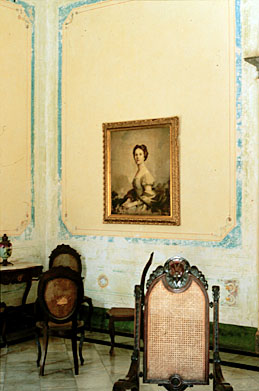 |
|
photo
by Mimi Chakarova
|
Sentiment aside, the pocket-sized
object also represents a better standard of living. In the last few
years, Spain has begun offering pension money to its foreign citizens
over age 65 in Cuba. "The announcement was like an explosion in
Havana," says Molina, who waited - with about 1,000 other people
- to apply for her mother's pension money last year. On average the
pensions range from $500-800, which is equivalent to winning the lottery
in a country where the average income is $12 a month. As a direct result
of the pension offer, the number of people applying for Spanish passports
has nearly tripled since 1998, to 6,000 in 2000. But while the money
provides welcome financial relief, it only highlights the deep economic
divide between Cubans and Spaniards.
"It broke my heart
to see doctors and teachers - educated people -waiting there for Spanish
charity," Molina says, watching her mother's aged face, serene
under a halo of white hair. Still, measured by the number of people
who line up outside the Embassy, Cubans are eager to accept Spain's
offer.
Elvis Mendoza's eyes are
glazed over by the time he reaches the shady gardens of the Spanish
Embassy. He is squeezed uncomfortably onto a narrow wooden bench next
to a sunken old woman nodding off in the stifling heat. Nearly 300 miles
separate the capital from Mendoza's rural home in the tobacco-growing
region of Sancti Spiritus. This time his journey spanned 24 hours. The
adventure included a delayed train, a broken down bus, and a communal
taxi crammed to capacity. Now inside the gates of the elegant mansion
– one of Havana's few restored colonial buildings - the shy man
is giddy with nervous energy and entirely out of his element. Still,
his mission lends him strength; Mendoza's aging mother has a Spanish
passport and needs money. The Spanish Embassy's humanitarian aid program
is her last hope. "My mother sent me instead of my brother,"
Mendoza jokes, "because he's even more guajiro than I am,"
he says, using the affectionate name reserved for country folks from
the provinces.
Mendoza is the living legacy
of Spain's roots in Cuba. His Spanish-born grandfather immigrated to
Cuba in 1917, among the last wave of Spanish immigrants destined for
the island after Spain lost the war. Like him, one-third of the 3.5
million Spaniards who left Spain between the late 1800s and 1930 were
destined for Cuba. "They were attracted to a place where there
are still family connections," explains Joaquín Roy, a professor
of Spanish-Cuban relations. On the island, Mendoza's grandfather raised
his family with Spain in his heart. He told stories to his grandson
about peasants working the dry earth in Extremadura, of Arab palaces
among olive trees in the south, and of gruff fishermen in northern Galicia.
Mendoza has never been to Spain, but says he has imagined it all his
life. "Because of my grandfather, I've always felt very Spanish."
But this journey to the capital is for practical rather than nostalgic
reasons. Mendoza's family has heard about the pension money and he is
in Havana to claim his mother's birthright.
| "It
broke my heart to see doctors and teachers - educated people -waiting
there for Spanish charity," Molina says, watching her mother's
aged face, serene under a halo of white hair. |
Mendoza has a lot of company.
In 2000 alone, 3,200 Cubans were registered to collect the Spanish pension
money. Most days, long lines of people snake down the sidewalk outside
the Spanish Embassy a block from the Malecón waterfront boulevard.
Some pace to break the monotony. Others animatedly compare family histories
and commiserate about the wait. A 17-year old named Fernando shows a
generous smile as he reclines against the building, ducking out of the
slant of mid-morning sun already threatening to boil the pavement. He
says his family has been to the Embassy several times in the past seven
months. "Here we go again," he grins. Nearby, Fernando's mother
holds their place in line, patient in her bright flowered dress that
pulls a bit too tight in the arms. She clutches faded documents - a
birth certificate and letters - that could pave the way to Spanish citizenship.
For those around her – whose other option is the dangerous 90-mile
water passage to the United States – a Spanish passport offers
a legitimate way out of Cuba provided they can somehow afford the airfare.
It's a legitimate path,
but often long-delayed. Most business requires much bureaucratic paper
pushing and shifting feet in line. Still, Cubans arrive and wait –
something to which they are long accustomed. Just around the corner
from where Fernando and his mother stand winds another line of people.
This one is reserved for married couples trying to get a travel visa
for the Cuban spouse. In line are all types; middle-aged couples who
have been married for years in Cuba and simply want to visit family
in Spain together; fresh-faced newlyweds; and older Spaniards with young,
dark-skinned Cuban women – an increasingly common image in Havana's
dollar-run tourist bars and nightclubs.
For Cubans like these with
no Spanish bloodlines, the doorway out is often through marriage –
a process that can be just as frustrating as applying for Spanish citizenship.
Couples schedule numerous interviews at the Embassy, often waiting for
hours. Even with the hassles, Spain remains a popular destination for
love matches these days, in part because of language and historical
ties. Beginning in the early 1990s when the economy plummeted, Cuban
wives and lovers began turning up in Spain. Today, some 3,000 Cubans
who are married to Spaniards apply for visas each year. This compared
to just 15 yearly applicants a decade ago, says María Cruz Arias
of the Spanish Consulate in Havana. The dramatic rise, Arias says, has
coincided directly with the tourist boom. Some marry for love; some
marry to escape the island. Still other Cubans find their way to Spain
each year through study exchanges, training programs, and business connections.
In 2000, nearly 300 Cuban students were awarded study grants to travel
to Spain. Once there, many never return to the island.
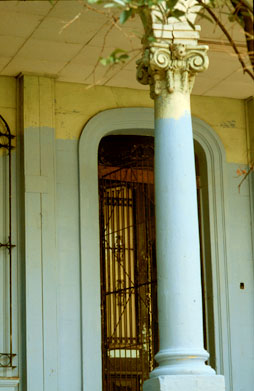 |
|
photo
by Mimi Chakarova
|
Beatriz Ávila is
not going back any time soon. She arrived in Spain with a four-year
study grant from the Spanish government and quickly found a well-paid
job in a private clinic. Though she now calls Spain home and has applied
for residency, she admits frustration over Spanish stereotypes of Cubans.
"Most Spaniards only think of Cuba for its famous sexual tourism,"
she says by phone from Madrid. "Sometimes when I meet people here
in Spain, they make offensive comments about Cuban women." Still,
Ávila says she doesn't see herself fitting back into the pattern
of Cuban society after having been away so long. For her, Spain is the
next best thing, given the two nations' intimate relationship. Many
Cubans apparently agree. The community grew quietly after the fall of
the Soviet Union, and by 1996 there were 7,000 Cubans living in Spain.
Today, there are about 16,000, making Spain home to the largest Cuban
community outside the island after Miami. There is no doubt the European
nation has a nostalgic pull. Castro himself is the son of Spanish immigrants,
and in 1984 he made a historic visit to the remote northern region of
Galicia where his father was born. Castro's ex-wife and daughter both
live in Spain, as do an ever-increasing number of artists, writers,
athletes and political dissidents.
But leaving the island is
not the only desire fueling the relationship between Cuba and Spain
in recent years. There is no denying each has something the other wants.
No one knows that better than Eusebio Leal, who as Historian of the
City of Havana is one of the most powerful men on the island. On a humid
afternoon in his Old Havana office, he faces a dozen wide-eyed visiting
student architects and poses the question: "Which is more important:
food or beauty?". With no hesitation, he answers himself: Beauty.
Yet Havana's beauty is ravaged by time; those early Spaniards would
barely recognize the Caribbean gem they so loved. Its splendor is tarnished
by peeling paint and gaping cracks. The ocean knocks relentlessly against
the Malecón's rocky sea wall, its salty spray licking buildings
and warping facades. If the sad image tugs on proud Cuban hearts, it
has an equally strong effect on Spanish sensibilities. After all, Spain's
history lives in the island's architecture. "For all our projects
we need money, lots and lots of money," says the beige-clad Leal,
his voice resonating through the corridor of a room. Spain is one of
his biggest collaborators. In addition to the newly-restored colonial
Spanish Cultural Center, money from Spanish regions is being used to
restore sea front homes all along the Malecón. Cuban men and
boys mix cement under the glaring sun at construction sites as vintage
Plymouths speed by, pausing only to pick up pretty young women hitching
rides. The projects are collaborative; Spain provides the funds and
Cuba provides the manpower. But like most joint ventures, there are
bumps in the road. Leal says frictions occasionally arise when Spain
tries to exert too much control. Still, Cubans know to tread lightly
where cash is concerned. "We have to pursue money where we can
get it," Leal states matter-of-factly.
Spanish generosity extends
beyond architecture. By late 2001, a long-awaited Spanish-funded water
project – restoring the century-old Albear aqueduct - will provide
16 percent of Havana's residents with purified drinking water. Spain
is also Cuba's most enthusiastic partner in cinematography. The European
nation funds half the films made each year on the island and finances
extensive archival restoration.
This new level of collaboration
between the old colonizer and her dearest colony is sparking some unusual
partnerships. In one of Havana's restored colonial jewels, Cuca Llagostera
now holds court. Wearing a stylish linen suit, the petite blonde looks
dressed for a chic downtown venue in Madrid rather than a quaint hole
in the wall in Old Havana. But then she throws on an apron, casually
snuffs out the cigarette dangling from between her lips, and heads for
the kitchen. There she whips up Spanish tortillas and fried garbanzos
in one of two restaurants that she manages with a Spanish partner in
the heart of Havana's tourist zone. At the Mesón de la Flota
restaurant, Spanish wines are stacked along the wall: Merlots from Barcelona,
Solmayor from La Mancha, and the occasional local wine from Pinar del
Rio province. Two Cuban waitresses gossip at the bar, their curls twisted
up inside identical flower wreaths.
| "The
Spanish business people in Cuba aren't interested in cultural associations,"
laments Barros Lopez. "It's like we live in two separate worlds." |
Though she is one of an
estimated 10,000 Spanish citizens who have recently immigrated to the
island, Llagostera's story differs from that of the typical entrepreneur.
She ended up in Cuba with her husband, who works in a joint business
venture in shipping. That water theme is everywhere. A miniature ship
model rests above the bar, and fishing nets drape gracefully next to
filmy black and red flamenco shawls on the pale walls. A sign outside
advertises the restaurant as "4,000 nautical miles from the point
of departure," playing off the image of the Spanish conquistadores
who reached Cuba by ship in the 1500s.
"The sea here reminds
me of Spain," says the Barcelona native, at home in her new surroundings.
A slow smile creeps across her calm, sun-tanned face at the suggestion
that she is setting a new trend for Spanish women in Cuba. "We're
definitely pioneers of a sort, my partner and I. There are very few
others doing what we've done here with the restaurants." Downtown
regulars, businessmen, and tourists keep the kitchen staff busy, and
Llagostera greets local patrons warmly, joking with her young, attractive
Cuban staff. Still, Llagostera's point of reference is always Spain.
"Most of my friends here are Spanish," she says. "We
usually get together at each others' homes or at restaurants and form
our own social groups." Many of her compatriots feel the same way.
Pereda from the hotel in Varadero maintains his loyalty to Spain, even
after 11 years in Cuba's tourist industry. He vacations in the cool
green hills of his native land in northern Castille and León,
and prefers Spanish matadors to Cuban baseball stars. As part of a new
generation of Spanish expats mainly focused on business activities,
it benefits them all to remain connected to the powerful Spanish business
community.
And their children follow
suit. Even as Spaniards mingle with Cubans on a day-to-day basis, they
still maintain distinct separations. Across town from Llagostera's restaurant,
in the peaceful, tree-lined Miramar neighborhood, is the Spanish School.
"It's just as if the students were in Spain," explains Javier
Rivera, the school's charismatic young Cuban director. Here among foreign
embassies and diplomats' homes students study a strict Spanish curriculum.
Exams are sent to Spain to be corrected, and students must wait weeks
to get their results back by mail. "It's not the best system for
the students," Rivera concedes, "but the instruction is excellent."
While the basics of math
and science vary little, Rivera says Spanish and Cuban education systems
part ways where philosophy and history are concerned. Greek philosophers
like Aristotle and Plato reign in the Spanish School, while Cuban kids
study Stalinist theory. And while Cuban students, in their tidy yellow
and red school uniforms, memorize the island's history, the Spanish
curriculum focuses on world history. "Unfortunately, they don't
have time to study the history of Cuba, the country in which they reside,"
Rivera says. The majority of the Spanish students – who comprise
nearly half of the entirely international student body - are the children
of business executives. "If the business goes well, they don't
leave," Rivera says. Things are going well. The school opened with
16 students in 1986; it now boasts 140. In a country where education
is free, the Spanish School's price tag is far beyond the average Cuban
family's reach. The two groups, for the most part, remain separate.
"Spanish kids only integrate into Cuban society if their parents
do," says Rivera, whose own daughter cannot attend the Spanish
School because she is Cuban. Smiling through cigarette haze at her restaurant,
Llagostera puts it more bluntly: "When you are very far from Spain,
it's natural that you would want to spend time with other Spaniards."
|
"Each
year the assistance packages are a little smaller," Barros
Lopez says, referring to the packages of soap, food and presents
that used to arrive from Spain.
In
the midst of the Spanish investment boom on the island, Barros
Lopez confides, "I don't see a bright future for the cultural
associations."
|
Although that comment would
make him flinch, Jesus Barros Lopez, president of the Galician Association
in Havana, also knows it's true. Part of the problem is economics, but
part is that the Cubans who strongly identify with their Spanish roots
are an older generation than the fast-paced peninsulares. Only a few
miles across town from Llagostera's restaurant - but eons away - is
the Galician Cultural Center, one of more than 100 Spanish cultural
associations that still exist in Havana. "The Spanish business
people in Cuba aren't interested in cultural associations," laments
Barros Lopez. "It's like we live in two separate worlds."
And they do. While Llagostera and her contemporaries enjoy going to
clubs and socializing at private parties, the 83-year-old Barros Lopez
spends his Saturday evenings at cultural presentations in the stately
mansion that houses the Center on the corner of the Parque Central.
Up a sweeping stairway,
in a cool, cavernous room far removed from the bustle outside, a few
older men are gathered at a table talking club business; dues, gaeta
music workshops, and the weekend event in the great salon. Galician
historians, poets and politicians peer out from wall paintings. Two
flags – one Galician, the other Spanish - stand at attention. "Gallego!"
one of the men suddenly shouts. From a raised platform at the back of
the room, a rumbling voice calls back, "Hold on, I'm busy."
Barros Lopez smiles. "They call me Gallego, but I'm Cuban born
of course. None of us is really from Spain anymore. We're just the sons
of Gallegos."
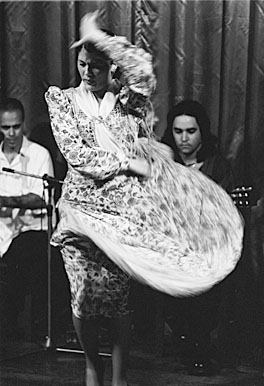 |
|
photo
by Mimi Chakarova
|
Wiry and gently bent with
age, Barros Lopez presides over a desk in danger of collapse. His hand
taps a pile of history books and board games, punctuating each word:
"There is less and less Spanish cultural presence in Cuba."
Not so in the old days. In its heyday, the thriving Galician Center
boasted 60,000 active members. But following the Cuban Revolution in
1959, cultural centers all but died out as the Cuban government aggressively
promoted unity through nationalism. The situation shifted again during
the financial crisis of the early 1990s. In the ensuing years, Spanish
associations resurfaced as important funnels for monetary aid to Cubans.
Consequently, association membership began to grow. "We've been
locating Spanish descendants all over the island," says Bruno Leyva
at the Andalusian Center, a short walk down the Paseo del Prado from
the Galician Center. "Many don't even know they have a right to
be a member." These efforts seem to be paying off. The Andalusian
Center's membership jumped from 400 in 1997 to 650 today. But the members
belong to a younger generation with little direct connection to Spain.
To maintain ties, a small number of older Cubans travel each year to
Galicia, funded by the Galician government. But people are dying off.
"Each year the assistance packages are a little smaller,"
Barros Lopez says, referring to the packages of soap, food and presents
that used to arrive from Spain. In the midst of the Spanish investment
boom on the island, Barros Lopez confides, "I don't see a bright
future for the cultural associations."
Most Cuban schoolgirls,
however, would be devastated if the centers closed. Of the many aspects
of Spanish culture, traditional dance is thriving on the island. After-school
flamenco class is the latest rage. Thirty pony-tailed little girls whirl
like dervishes on and off a narrow wooden stage at the Andalusian Cultural
Center. The mad clacking of castanets combines with the feverish pounding
of high-heel dance shoes and the swish swoosh of multi-colored ruffled
skirts. A soloist steps to center stage, her face as proud and pained
as any flamenco diva in Spain. The harried instructor in her matching
vest and mini skirt, barks, "Arms! Watch the arms!" while
rotating her wrists like fans, her fingers painting the air. The older
girls imitate her, faces pinched in concentration, while the younger
ones tickle each other in the wings. "Silence!" the teacher
shouts, mouthing around her fifth cigarette. Attempts at another remonstration
fail along with her voice. "Next time somebody bring me a microphone,"
she rasps.
No one is listening anyway;
the Cuban mothers watching from the street through open windows are
as swept up as their daughters in the haunting boleros and playful Sevillanas
crackling over the loud speakers. Eleven-year old Johanna takes breaks
every five minutes to pose and wave to her mom. "I've been taking
classes since I was six," she says proudly during one of her visits
to the window. Johanna is Afro-Cuban, and lured - as are her companions
– by the novelty of Spanish dance.
But no Spanish girls are
dancing with the Cubans on stage. "They don't go to flamenco dance
classes," says principal Rivera from the Spanish School. "Their
parents are more interested in practical activities – like English
classes."
Back
to stories page



